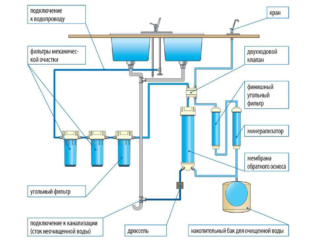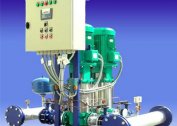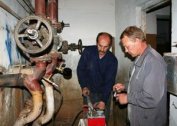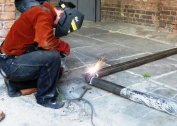The autonomous water supply system uses water from wells and boreholes. Its quality does not always comply with safety standards. Organic and mineral substances are dissolved in it. Their high concentration can be harmful to health, leave scale on the surface of the heating elements. Membrane water treatment technologies are a modern and effective method. It is based on multi-stage filtration. The installation of the membrane provides purification of the liquid at the molecular level.
The device and principle of operation of membrane filters for water
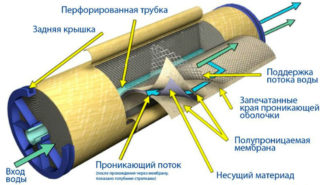 The main element of the filter is a membrane. It is made from synthetic materials (lavsan, propylene, cellulose). A porous film passes water and oxygen molecules, trapping impurities. The cleaning parameters depend on the size of the holes. Organic and mineral substances, the diameter of which exceeds the pores, remain on the surface of the filter. The performance of the device depends on several factors:
The main element of the filter is a membrane. It is made from synthetic materials (lavsan, propylene, cellulose). A porous film passes water and oxygen molecules, trapping impurities. The cleaning parameters depend on the size of the holes. Organic and mineral substances, the diameter of which exceeds the pores, remain on the surface of the filter. The performance of the device depends on several factors:
- degree of liquid contamination;
- system pressure;
- water temperature;
- membrane area.
When passing through the filter, water is divided into two streams. One is directed through the pores of the membrane. Passing through several layers of synthetic material, it is cleaned of harmful impurities. The second stream is used to remove deposits.
The liquid freed from contamination is called permeate. It is fed into the plumbing system. Water flushing the trapped impurities (concentrate) is sent to the sewer or used for household needs. A high level of purification allows drinking liquid without boiling.
Types and design of membranes
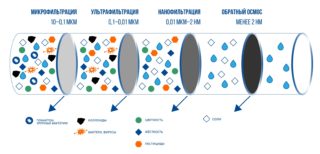 Membrane elements differ in pore size and degree of fluid purification:
Membrane elements differ in pore size and degree of fluid purification:
- Microfiltration - the size of the holes is 0.1-1 microns. The material is used for pre-filtering, separating fine suspensions and colloidal impurities. The liquid becomes transparent.
- Ultrafiltration - parameters 0.1-0.02 microns, algae, microorganisms, metal oxides, small colloids are removed.
- Nanofiltration - pore diameter 0.02-0.001 μm. The filter is capable of extracting heavy metals and chlorine compounds from water. The liquid comes out softened, the salt composition changes slightly.
- Reverse osmosis - the smallest holes in the membrane are 0.001-0.0001 microns. The material retains all impurities dissolved in water. Reverse osmosis systems remove bacteria, salts, pesticides, oil products. They are used in pharmacology, seawater desalination plants.
Membrane filters are classified by the shape of the cleaning element.
Flat disk
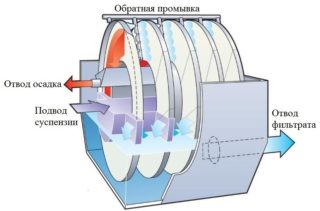 Disc-type filter films are usually installed to clean large volumes of water. Work items come in three forms:
Disc-type filter films are usually installed to clean large volumes of water. Work items come in three forms:
- reinforced - a polymer porous film is applied to a fabric base;
- epigastric - the design provides for the use of an additional layer of material with large holes;
- non-substrate - are made of a homogeneous material (polyamide, nylon, fluoroplastic).
Disc membrane elements are in the least demand.
Roll
 The most successful constructive solution, this option is used for reverse osmosis plants. It represents a membrane element wound in the form of a roll onto a perforated tube. Water flows from the end of the module, moves in a spiral towards the center. Passing several layers from the main membrane and polyester substrates, it gets rid of impurities.Separation nets prevent adhesion of the working material. The concentrate is discharged into the sewer.
The most successful constructive solution, this option is used for reverse osmosis plants. It represents a membrane element wound in the form of a roll onto a perforated tube. Water flows from the end of the module, moves in a spiral towards the center. Passing several layers from the main membrane and polyester substrates, it gets rid of impurities.Separation nets prevent adhesion of the working material. The concentrate is discharged into the sewer.
Tubular
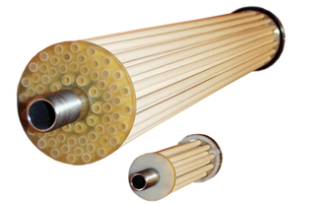 The filter module is filled with tubes made of porous material (ceramic, cermet or plastic). The location of the holes in them is symmetrical and asymmetric. Fluid under pressure passes the working layer, on which contamination remains. The purified water is collected in a storage tank, the concentrate is discharged into a drain through a separate hole. Tubular ceramic modules are the best option for installation in a centralized water supply network. They trap particles of iron, salts, are not sensitive to abrasive particles.
The filter module is filled with tubes made of porous material (ceramic, cermet or plastic). The location of the holes in them is symmetrical and asymmetric. Fluid under pressure passes the working layer, on which contamination remains. The purified water is collected in a storage tank, the concentrate is discharged into a drain through a separate hole. Tubular ceramic modules are the best option for installation in a centralized water supply network. They trap particles of iron, salts, are not sensitive to abrasive particles.
Hollow fiber
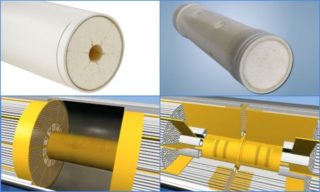 Modules consist of a large number of thin tubes (with a diameter of about 1 mm). Their walls are covered with microscopic holes. Filters capture iron impurities, microorganisms, bacteria, Giardia cysts. The use of multiple elements increases the total filtering surface area. Hollow fiber membranes are prone to clogging soon. Before them, it is recommended to carry out mechanical cleaning of the liquid.
Modules consist of a large number of thin tubes (with a diameter of about 1 mm). Their walls are covered with microscopic holes. Filters capture iron impurities, microorganisms, bacteria, Giardia cysts. The use of multiple elements increases the total filtering surface area. Hollow fiber membranes are prone to clogging soon. Before them, it is recommended to carry out mechanical cleaning of the liquid.
For use in camp conditions or in the country, track membrane filters are offered. The design is immersed in a container of water, the purified liquid is discharged by a drain pipe.
Criterias of choice
Before buying a filter design, the used water is given for examination. The conclusion about its composition will tell you what type of membrane to install. High requirements for the quality of water treatment require the installation of a reverse osmosis system. When choosing a membrane, the pressure in the water supply network of the house is taken into account.
For the operation of the ultra- or nanofilter, 1-2 atmospheres are sufficient; reverse osmosis will require a pressure increase to 3-3.5 atmospheres. The cost of the filter design depends on its capabilities. The most efficient system has a high price. The performance of the installation is selected by the average parameter of water consumption of the family.
Features of installation and operation
The membrane filter is mounted on a cold water pipe. A rational installation option is under the sink in the kitchen. The device is located close to the consumption tap and sewer. The installation procedure is indicated in the instructions. Before starting work, the movement of water in the system is blocked. Residues are drained by opening a tap. The tap drain assembly spins.
A tee and ball valve are installed on the line. A separate faucet is mounted on the sink for the receipt of purified water. The filter unit is assembled according to the instructions. Before installing the reverse osmosis system, it is necessary to install several pre-treatment modules (mechanical, coal).
The membrane needs regular washing. It is placed under the pressure of hot (40 °) water. With severe contamination, the block is lowered into a solution of citric acid for 20-30 minutes. Then the part is thoroughly washed under a cool stream. The lifetime of the membrane module is 1-3 years, it is indicated by the manufacturer. A signal about the need for replacement is a decrease in the pressure of the liquid and the appearance of a taste.
Advantages and disadvantages
Advantages of membrane filters for water:
- high degree of purification;
- convenient and easy operation;
- long term of use and the possibility of self-service;
- compact size.
Disadvantages:
- significant water consumption;
- a high degree of removal of minerals from the liquid during reverse osmosis;
- the need for mounting the output into the sewer.
Membrane water treatment methods are used for domestic, medical and technical purposes. When installing the system in an apartment, it is necessary to periodically monitor the level of salts in the liquid using a TDS tester.
